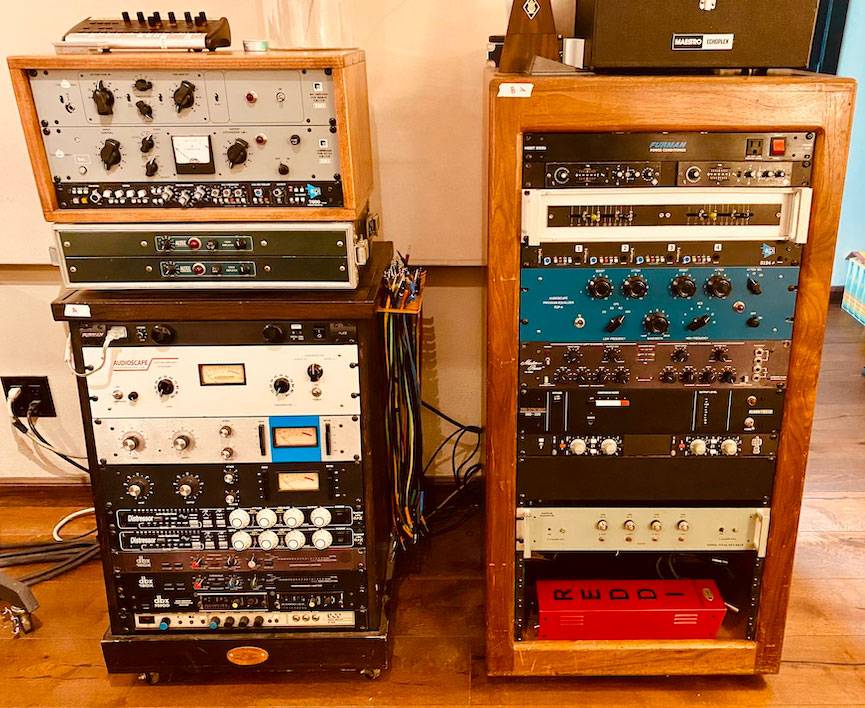-
 play_arrow
play_arrow
Clubalicious Clubalicious Radio
-
 play_arrow
play_arrow
London Calling Podcast Yana Bolder

Los Angeles, CA (November 20, 2024)—The screensaver at Zac Carper’s studio in the Frogtown neighborhood of Los Angeles says, “Get Back to Work You Donkey.” Carper, the prolific songwriter/ producer and frontman of Fidlar, says this message is meant to keep him focused, but it’s evident from his output that he doesn’t need the reminder.
The Los Angeles surf-punk trio’s self-recorded and self-produced fourth album, Surviving the Dream, was released in September 2024, five years after Fidlar’s last long player. In the interim, Carper has produced a death metal band, a country album and an art pop/punk record.
“When I was doing a lot of drugs, I was so creative, but it would come out in bursts; I was not consistent at all,” Carper says matter-of-factly. Substances have been phased out of the Fidlar stable, and with that, Carper says, “I can’t rely on inspiration that much. I have to rely on discipline. I call it ‘microfesting,’ like microdosing manifestation.”
Even though writing, recording and touring with Fidlar—an acronym for “F— It Dawg, Life’s A Risk”—is a full-time job, producing was Carper’s goal when he first moved to Los Angeles from his native Hawaii. Drawing from his experiences producing other artists, as well as from the varied producers the group has worked with over the past 15 years, Carper was in a good position to step into the role for Surviving the Dream.

As Fidlar’s principal songwriter, Carper’s lyrics start with stream-of-consciousness writing so extensive that his notebook ends up black with ink. These pages keep his writing flowing. “It helps me figure out what I really want to say,” he says. On the flip side of this same notebook, he writes lyrics, which he initially approaches as poetry, then phrasing, then singing. Sometimes he’ll have a “floating paper” where he writes lines, from which he pulls out words. There is also the Notes app on his phone to collect phrases he overhears.
On the road, Carper brings a laptop for recording, a ukulele and a cheap acoustic guitar, a Focusrite Scarlett Solo and a Shure RS230 microphone, “because it has an on/off switch,” he laughs. “I write a lot on tour because the routine is very military and it gives me space to write in my head. And every time I produce someone else, I always write a song or two. Working on somebody else’s art reminds me of making my own.”
While Fidlar’s no-holds-barred songs sound like a deranged all-night party where the members are playing their instruments at full speed in the room together, Carper’s focus when writing is the vocal melody and the lyrics. “Our heaviest, metal-ish kind of songs are me playing on the piano, one note at a time,” he says. “Ninety percent of the time, the songs start on ukulele.”

SONGWRITING WHILE DEMOING
The ukulele is Carper’s first instrument and the basis for the first iteration of a song he records. He then tracks an acoustic guitar version, a piano version, a speeded-up guitar version. He calls these “drafts,” and with each one, he might change the pitch or add a new section. He sets a 20-minute time limit on each version, does two or three takes and once the timer goes off, he stops recording that rendition. He does the same with bass and drums.
In this way, Carper moves steadily through his demoing process, which typically results in five to seven drafts. Once he has all the parts mapped out, he pulls the stems, usually written on Ableton, and puts them into Pro Tools to bring to Fidlar’s drummer, Max Kuehn, and bassist, Brandon Schwartzel. (Guitarist Elvin Kuehn has departed the group.)
“It’s only when I feel I can present it to my band members that I feel I have a song,” says Carper, who, with his bandmates, did most of the final tracking at Balboa Recording Studio in Los Angeles. “When it gets to them, I delete my drums, I delete my bass, and say, ‘Play whatever inspires you.’ The mantra is, ‘How do we make this go off live? How do we make more energy?’ Then I’ll go through the process of elimination. I don’t have more than one melody going on at the same time, or, if it’s a different melody, I make sure it’s a reverb or a bed.
“It’s crazy how much of it revolves around my confidence,” he continues. “A lot of it is being willing to fall and bounce back. If the song doesn’t work, you don’t have to throw it away. What do you like about it? Accentuate that.”
Carper records vocals on his own, using a Shure SM7B or 58 microphone (“I like holding it, and I can cup it”), going through a Chandler TG2. He keeps the chain clean to have more flexibility later. Soundtoys Decapitator and Yamaha SPX90 multi-effects processors appear often on Surviving the Dream. Carper used the symphonic setting number 15 on the latter, a tip from a Mix with the Masters video featuring Andy Wallace.
“I sing the song all the way through, and then I’ll do it over and over again, but I never double or triple things,” he says, noting that his vocals for Surviving the Dream were recorded in an Airbnb in Joshua Tree. “I sing it until it’s nailed in my head. Then I’ll take a new track and use the old takes as doubles and triples. I do a center vocal, just one lead vocal, and then a left and a right double and a triple, and the fourth one is chorus, and I tuck everything down.”

TRACKING THE BAND
The bass is captured via DIs, but Carper also nabs it through the Tech 21 SansAmp VT bass pedal and a 15-inch cabinet; nothing bigger, he says, as it tends to create phasing issues. Carper’s intention with drums is to get them as big as possible while maintaining a vintage sound. To achieve that, he uses primarily ribbon microphones, working from the bottom up, hitting each piece of the kit until it “sounds sick,” then miking it—a trick he learned from producer Ricky Reed. From his own experience, he has found that fewer drums in a large room are enough to get a big drum sound.
Guitars are also captured via DI with an array of amps: Marshall 4×12 or 2×12 cabinets and an EVH 5150 2×12 with a direct-out speaker emulator. Carper’s guitars of choice are the Music Man St Vincent signature and Schecter Sun Valley Super Shredder with Floyd Rose and Sustainiac Stealth PRO system.
“It’s like one big feedback machine,” he says. “I’ll play the chord, hold it, and record it through the whole song. There’s this feedback feel to it. I like to experiment with a lot of active pickups. I like drop tunings. I’ll layer those in to get different voicings. I run the acoustic guitar through an acoustic simulator. I like what I call ‘inspiration pedals,’ but I don’t like vintage-sounding ones.”
Every instrument (including vocals) is sent to Pro Tools after passing through some type of classic gear from the 1980s. This era was a new discovery for Carper during the creation of Surviving the Dream. He namechecks Tears for Fears, A-ha and Ozzy Osbourne records, with their chorusing guitars, as sounds that caught his ear. He bought a bunch of old units, which are set up on every surface of his studio: Alesis MIDIVerb 4, Ensoniq DP/4 and the SPX90. Plus, Roland Juno-6, Fender Rhodes, Yamaha DX7 and a LinnDrum.
“This forgotten gear from the ’80s really inspired me,” Carper says. “They’re badly made, really cheap. They’re not tube; they’re IC chips. I would run all the guitars through these things, not really knowing what I was doing. It’s like learning how to use a new DAW: I don’t know how to do it, but that makes me excited to learn, and I’ll often stumble across a new sound.”
Although Carper mixes the artists he produces, when it comes to Fidlar, he puts that responsibility in the hands of others. For Surviving the Dream, it was Lars Stalfors, whom he handed a rough mix that was as far along as Carper could take it.
“I don’t go back to the second mix,” he says. “My theory is, I don’t listen to my own music, so I’m not my target audience. Doing my own mixes with Fidlar, I can rely on my ears and get it to a certain point. Once you start getting into the weeds, you trip yourself up. I’m all about the pass-off and trying not to be precious about it. The reason I can let go is because I get that done to me a lot through bands I produce. You have to check your ego.”
Written by: Admin
Similar posts
Recent Comments
No comments to show.Featured post

Latest posts
Current show
Upcoming shows

Love To Be
The Global Connection
09:00 - 11:00
Fresh Is Fresh
This Weeks Hottest Releases
11:00 - 15:00
House Story
Dance Anthems
15:00 - 17:00
STARDUST
Presented by Bergwall
17:00 - 19:00
Femme House
Lp giobbi
19:00 - 20:00Chart
Powered by Dee jay promotions visit us













 Invalid license, for more info click here
Invalid license, for more info click here